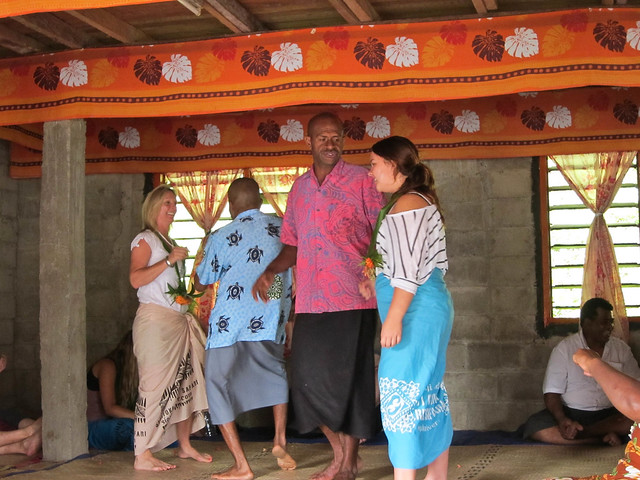Village visits are a tricky thing, aren’t they? On the one hand, it’s so interesting to see traditional life up close and there’s always the chance of making a real connection with the people you meet. On the other, tours that promise to take you to a “traditional” village often seem fake, staged and sometimes exploitive. At least this has been my experience in the past, both in Asia and Latin America.
When I first saw the flyer for Sigatoka River Safari I’ll admit I was pretty skeptical. A jetboat cruise sounds fun, but not necessarily like the most authentic experience, even with a village visit thrown in. How can you create a unique and real experience with a boat full of 20 western tourists?
In Fiji traditional village life is very much the norm for most native Fijians. Many of the tour guides, hotel workers and professionals we met still go back to their home villages each night. To truly understand Fiji, you need to get outside of the cities and resorts and visit at least one native community. So I tried to keep an open mind, and Sigatoka ended up surprising me.

It had already started to rain when we reached the Sigatoka River which stretches deeply inland from the coast of Viti Levu. The speed boat was awesome fun. It whipped up the river, making hairpin turns and dramatic splashes while the driver grinned like someone who truly loves his job. 25 minutes later we pulled up to the shore where we were met by an absolutely beautiful woman who would be our village guide, Aggie.
The village was called Natawatawadi, which means “Always Quiet.” It did seem like a peaceful, spartan place, not all all corny or hokey like I expected. This is because the tour company takes great pains to make sure that the villages are not overloaded and overrun with tourists. Every day the tour visits a different village: they alternate seven and then switch every six months, so that each village hosts once a week for a six month stretch, then gets six months off. Natawatawadi had the Saturday shift.

As we arrived in the village we were greeted by young women with necklaces woven from palm fronds and flowers. Aggie explained that the people in this area are descendants of the last cannibals of Fiji. Over a century ago they holed up in the nearby mountain caves, resistant to giving up their old ways (the tour company offers an alternate tour where you can tour those old caves and even see where the Reverend Baker met his culinary fate). Eventually the tribes came down from the mountains and embraced Christianity.
We went on a quick walk around the village in the rain. Aggie pointed out a decaying mess of boxes, which upon closer inspection were full of rich columns of marble. A few years back a Japanese firm came to take samples from the hills for testing, then abandoned the project. The hills are full of high grade marble but the villagers haven’t the slightest idea what to do with it or how to extract it.

It’s a sad irony as the village is legitimately poor. While everyone appeared well fed it was clear that resources were sparse and hard work necessary for survival. For the past few years they have been concentrating their efforts on saving up enough for running electricity.
Hosting visitors through Sigatoka River Safari brings in much needed extra money for the village. They receive a percentage of the high ticket price, and a committee is set up to make sure the money goes to village improvement works.
Aggie also points out the lime green school house across the river. Before they were able to purchase a boat, children would wade or swim across the river to get to school. Thanks to the money coming in from the tours, the village has started a scholarship program to send the brightest kids to get higher education.
After a traditional kava ceremony we set down for lunch: bananas, fried taro leave fritters, fried dough, curry wrapped in roti, chicken, fruits and more. The tourists eat while the locals watch, which feels uncomfortable at best. Next to me is a little boy, maybe 9 years old. “Hello,” he says shyly.
“What’s your name?”
“William,” I tell him that’s my brother’s name and he beams at me before dissolving into giggles.

Next came the dancing. The villagers sang their traditional songs, happy any rhythmic. One by one the young men of the village asked visitors to dance. Soon everyone was whirling around the room.
This is where it gets interesting: even though we were a group of tourists, and even though the villagers were compelled to be there, even with all the layers of artificiality, there was still a root of truth in there. As we danced song after song, I danced with handsome young men (sorry Mike), and distinguished older gentleman. I asked my little buddy William for a dance but he turned red and ran outside, so I danced with a brave and beautiful little girl instead. Best of all: the chief himself, asked me to dance not once, but twice. Man THAT guy had some insane moves.

We were all having fun. We were connecting, and that is a truth.
I don’t know, maybe it’s impossible to have a truly authentic experience when you’re on a group tour. But even in a tour like this there were real moments of connection, warmth and humanity. SRC is doing their best to improve the communities, not degrade them. It’s more authentic than any experience you’ll have inside a resort because there are real people here, trying to get by in their real life.
It’s a tricky line, but I felt like we walked the right side of it.
Special thanks to Tourism Fiji and Sigatoka River Safari.
